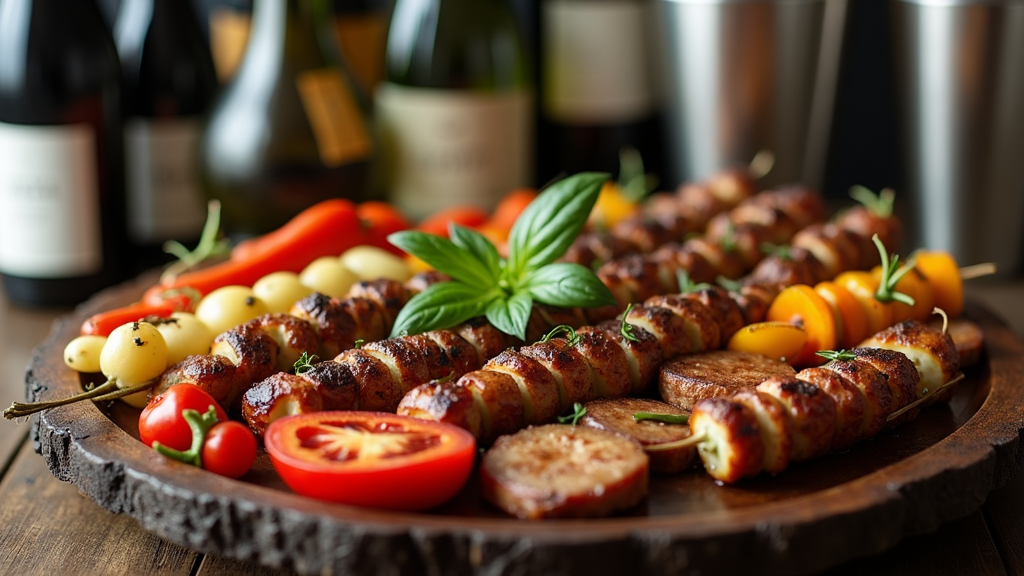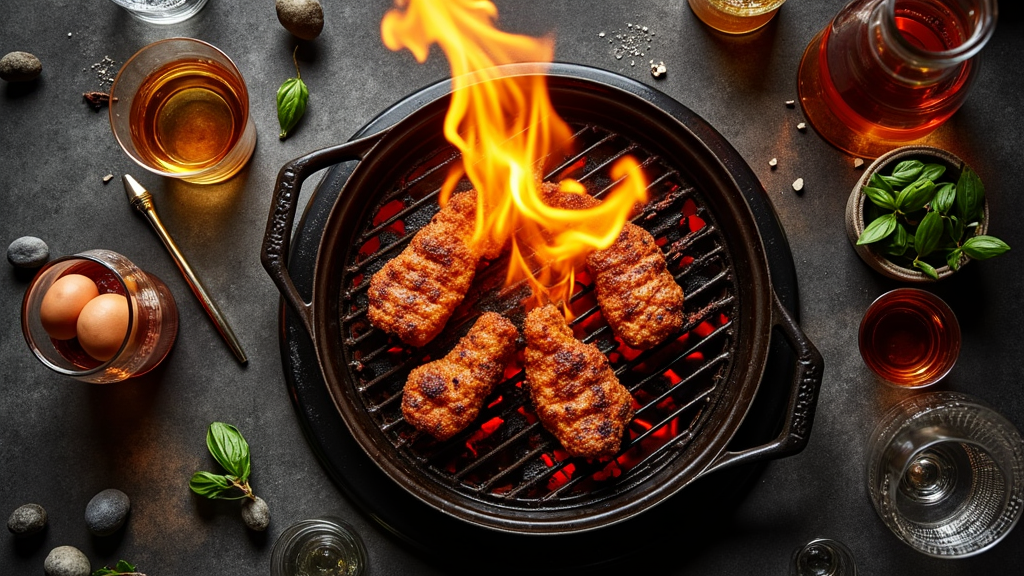Grilling foods has a way of bringing out bold flavors and rich textures that make every meal an adventure. I believe that pairing these foods with the right wines and cocktails can step up your dining experience to a whole new level. In this article, I will walk you through how to select perfect beverages that complement grilled dishes and add an extra spark to your meal time.

Core Principles for Pairing Beverages with Grilled Foods
Grilled foods have a unique taste that comes from smoky flavors and caramelized exteriors. To create harmony on the palate, it’s important to consider the food’s intensity, texture, and spices. When selecting a wine or cocktail to pair with your grilled meal, the idea is to step up those flavors without overpowering them.
Wines and cocktails each have their own characteristics that make them more or less suitable for certain dishes. For instance, a bold red wine might pair well with a beef steak, while a citrus-forward cocktail can perfectly complement lighter grilled seafood. Understanding these basic elements can help you create combinations that are balanced and enjoyable.
It is very important to note that there is an art and a science behind pairing drinks with food. Many successful chefs and culinary enthusiasts spend a good deal of time researching which profiles work well together. By reading up on flavor chemistry and experimenting with different ingredients, you can dig into the fascinating world of taste pairing. This all-in-one approach not only makes your meal more memorable but also invites you to think creatively about the interplay between flavors.
Getting Started: The Fundamentals of Pairing
The first step in mastering pairing is to get acquainted with the ingredients in both your food and your beverages. Grilled foods offer a wide variety of choices, from vegetables and meats to fish and even fruits. Meanwhile, wines and cocktails range from crisp whites and robust reds to refreshing spritzers and creative mixed drinks.
Some key terms worth learning include:
- Body: Refers to the weight and fullness of both food and drink. A full-bodied wine, for instance, demands rich and hearty flavors in the food it accompanies.
- Tannins: These are compounds found in red wines that contribute to a dry, puckering sensation. Grilled red meats often benefit from the structure tannins provide.
- Aroma: The scents in both food and drink help set the stage for flavor. Smokiness in a cocktail or the char from grilled food can create intricate layers of aroma when paired well.
By understanding these characteristics, you can start to see why some combinations work better than others. The main aim is to create a synergy that steps up the dining experience from the first sip and bite. To help you get started, consider spending an extra moment researching a particular region’s wine offerings or even visiting a local distillery. This hands-on exploration can be a real eye-opener, offering new ideas on how flavors can be intertwined.
Allow me to share an example: When I first began experimenting with pairings, I tried matching a lightly spiced grilled chicken with a delicate white wine. At first, the flavors seemed to clash, but after a few small adjustments, I found a combination that brought out subtle notes in both the dish and the drink. These early missteps taught me that patience and continuous tasting are key to nailing a perfect match.
Building Your Pairing Strategy
Once you embrace the basics, building a pairing strategy becomes a fun process of experimentation. Start simple. Choose one element of your meal and match it with a complementary drink. For example, a lightly grilled fish dish might pair well with a crisp, chilled white wine or a lively, citrus-based cocktail.
The key is to keep tasting and adjusting your selections. Don’t be afraid to try bold combinations. I have often found that the unexpected pairing of a smoky cocktail with grilled vegetables creates a refreshing twist that surprises the palate. There is no single rule that applies to every situation; sometimes the best combinations come from trial and error. Experiment with different ingredients and note which ones work well together. Write down your thoughts, and over time, you will begin to pick up on patterns that help you choose better pairings in the future.
Furthermore, consider hosting a tasting party with friends where you can sample a range of different combinations. Not only will this be a fun event, but it will also allow you to gather opinions and get a broader perspective on what pairings work best. When everyone shares their insights, you might just stumble upon a brilliant match that you never would have thought of on your own.
Considerations Specific to Grilled Courses
When working with grilled foods, several factors come into play that can influence your drink choices. Here are some points to keep in mind:
- Intensity of Smoke: The level of smokiness in your grilled food will affect the drink selection. A highly smoked meat might require a drink with enough structure to stand up to its boldness without losing the harmony of flavors.
- Fat Content: Rich, fatty meats can benefit from higher acidity or tannic structure in wines. Cocktails with a hint of bitterness also help cut through the fat, creating a balanced sensation.
- Spices and Marinades: Many grilled dishes are marinated or spiced, and this plays a role in your pairing decision. The spices might dictate a more subdued drink, one that doesn’t fight back too aggressively against the flavor layers.
- Cooking Technique: The method of grilling—whether it’s a quick sear over high heat or a slow smoke—impacts flavor depth. Each method may benefit from a slightly different beverage profile.
Taking time to appreciate these details makes all the difference. When you consider every element, your pairing choices will work seamlessly to highlight the taste of your food. It can be really important to plan ahead, especially if you are preparing a multi-course meal. This way, every dish, from the appetizer to the dessert course, gets the perfect drink partner to complement its unique flavor profile.
Steps to Perfect Your Pairing Technique
Here’s a brief guide to help you start pairing wines and cocktails with your grilled courses:
- Define the Main Flavor Profile: Begin by identifying whether your dish is more robust or delicate. Ask yourself if the dominant note is smoky, spicy, or savory. This step sets the foundation for your beverage choice.
- Select a Beverage Base: Decide if your pairing will be wine-based or cocktail-based. White wines typically offer light and fresh notes, while reds deliver fuller body and deeper tannins. Cocktails vary widely and can be tailored to match nearly any flavor profile.
- Match Intensity and Texture: The weight of the drink should mirror the richness of the food. A leaner dish might pair best with a lighter wine or a cocktail that has crisp, bright flavors, whereas a heavier dish calls for more robust choices.
- Experiment with Complementary and Contrasting Flavors: Sometimes pairing flavors that are similar can increase harmony, while contrasting flavors can create a pleasantly surprising balance. It’s all about trial and error.
- Tasting and Tweaking: Don’t hesitate to take notes and adjust your recipe on the fly. A quick taste during a meal can help determine if the balance is right or if a tweak is needed. This iterative process is part of the fun and helps you build confidence in your pairing abilities.
Once you have the basics down, consider dedicating time to experimenting outside of regular meal times. Set aside an evening where you can try out various pairings without the pressure of a dinner party. Write down the changes you make and how each tweak affects the overall flavor profile. Over time, these notes will serve as a valuable resource when planning future meals.
Potential Pitfalls to Avoid When Pairing
Pairing food with beverages may look simple at first, but there are a few common challenges that might arise. Here are some hurdles you might encounter and ways to address them:
- Overpowering Flavors: Using a drink that is too bold can mask the intricate flavors of your food. If the wine or cocktail dominates the palate, try choosing a milder option next time.
- Underaccentuating the Dish: On the flip side, a beverage that is too subtle may get lost when paired with a strongly flavored grilled item. It’s important to match the intensity properly.
- Mismatched Temperature: Serving beverages at the wrong temperature can detract from the pairing. For example, a chilled white wine might not match well with a hot, smoky dish if it loses its refreshing quality.
- Not Considering the Side Dishes: Often, grilled meals come with sides that have their own flavor profiles. It helps to think about the entire plate and not just the main course.
In addition to these points, it is very important to be patient with the process. Sometimes, what seems like a misfire in one course might be saved by a perfectly matched side. Taking a holistic view of your meal can help you identify which elements need adjustment. If one component feels off, rethinking your pairing strategy for that course can make all the difference.
Overpowering Flavors in Action
There have been times when a particularly full-bodied cocktail overshadowed a delicately grilled fish dish. When I adjusted by opting for a lighter beverage, the complexities of the grilled flavors truly stood out. Learning from these experiences is a big part of developing your pairing intuition. Small changes, such as choosing a drink with a less aggressive profile, can bring the flavors together in a balanced way.
Finding the Balance with Temperature
Temperature plays a quiet but important role. I once served a warm red wine with a lightly grilled vegetable platter that needed a crisp finish. A switch to serving a slightly chilled red made the pairing noticeably smoother, proving that small adjustments can make a big difference. These experiments taught me to always consider the serving temperature as an integral part of the overall pairing strategy.
Advanced Tips for the Experienced Pairer

Once you’ve got the basics down, there are some next-level cool techniques you can try to further refine your drink and dish pairings. If you’re looking for a bit more creative flair, consider these advanced approaches:
Play with Contrast: Sometimes, intentionally contrasting flavors can be delightful. A tart cocktail might work well with a rich, smoky piece of grilled meat. This intentional mix creates an interplay that is both surprising and balanced. Experiment with both similar and contrasting flavors to see how they interact on your palate.
Use Regional Pairings: Find inspiration by checking out how different regions pair local wines and cocktails with their grilled specialties. For instance, a Mediterranean dish might naturally pair with a crisp white wine while a Latin American grill might come alive with a citrusy cocktail. Doing a bit of homework on regional trends can help you map out exciting new pairings.
Experiment with Infusions: Don’t be afraid to customize your cocktails. Adding a hint of herbs or spices that echo the flavor notes in your grilled food can create a more integrated experience. For example, a rosemary-infused cocktail can be a great match for an herbed grilled lamb dish. This method not only makes the beverage more interesting but also ties the overall flavor profile together.
Mind the Finish: Pay attention to the aftertaste. A drink with a long, satisfying finish can complement the lingering flavors of a grilled dish, ensuring that neither the beverage nor the food is abruptly cut off on the palate. Taking extra time to select a drink that finishes well will truly take your pairing skills up a notch.
It is also really important to keep experimenting. As you become more confident in your choices, challenge yourself by pairing dishes with unfamiliar drinks. Over time, you may even develop a signature pairing style that becomes your personal hallmark in the kitchen.
Focus on Flavor Profiles When Choosing Pairings
Pairings aren’t just about matching one component with another—they’re about crafting an overall flavor narrative for your meal. I’ve found that focusing on the individual flavor profiles helps in creating dishes that sing in harmony. Every element on your plate contributes to the overall story of the meal.
For instance, grilled chicken with a light spice rub might work well with a semi-sweet white wine or a mildly spiced cocktail that features complementary fruit accents. Meanwhile, a hearty grilled steak or pork chop might pair best with a robust red wine or a cocktail that incorporates rich ingredients like aged spirits and bitters.
Consider how acidity, sweetness, and bitterness can work together or contrast. A high acid wine, such as a Sauvignon Blanc, might cut through the fattiness of a grilled dish, refreshing the palate between bites. On the other hand, cocktails that offer a subtle sweetness can work to mellow out intense, spicy flavors without completely masking them.
- For Lighter Grilled Dishes: Accents of citrus in a cocktail or a crisp, dry white wine can be refreshing. These beverages highlight the natural flavors without overwhelming them.
- For Heavier Meats: Rich reds and bold cocktails with herbal notes offer the heft needed to stand up to stronger flavors.
- For Vegetarian Options: Think about wines and cocktails that balance earthiness with brightness, such as a light rosé or a refreshing gin-based drink with herbal infusions.
This focus on flavor makes the experience of dining a more collaborative performance. Each part works in concert to create a memorable meal that allows every ingredient to shine. It is a process of connecting the dots between taste, aroma, and texture, and then stepping up the overall profile of the dish.
Frequently Asked Questions
Here are some common questions that might pop up as you fine-tune your pairing skills:
Question: How do I choose between wine and cocktails for my grilled meal?
Answer: Consider the flavor profile of your dish. Lighter grilled foods may lean toward crisp white wines or light cocktails, while richer, smoky flavors might pair better with full-bodied reds or more complex cocktail mixtures.
Question: What if my pairing seems off during the meal?
Answer: A small adjustment can make a big difference. Try serving the beverage at a slightly different temperature or experiment with a small-tweak ingredient in your cocktail. Continuous tasting and experimentation help you fix any imbalance.
Question: Are there any pairings I should avoid?
Answer: It’s best to avoid pairings where the beverage completely masks the taste of the food or vice versa. If a dish is particularly subtle, choose a drink with a gentle flavor profile. Conversely, very spicy or robust dishes need a drink that can complement or balance the intensity instead of simply adding more heat.
Wrapping Up Your Grilled Pairing Adventure
Bringing together the world of grilled foods with thoughtfully chosen wines and cocktails can really step up how you enjoy a meal. The balance of flavors, when done right, allows both the food and the drink to shine without one overwhelming the other. Spending time learning about flavor profiles, experimenting with different pairings, and paying attention to small details like temperature and spice level can make this adventure really enjoyable.
Remember, pairing is both a craft and an art. While there are guidelines to follow, some of the best breakthroughs happen when you step out of your comfort zone and try something new. I encourage you to use these tips as starting points. Allow yourself the freedom to mix things up and learn from every experiment. Each thoughtful adjustment and every note you take will help you build a deeper understanding of the intricate dance between food and drink.
Your adventure into pairing is an ongoing exploration. Every meal presents an opportunity to refine your approach and stumble upon combinations that are uniquely satisfying. Whether you’re hosting a backyard barbecue or preparing a special dinner at home, pairing the right wine or cocktail with your grilled foods sets the tone for an enjoyable meal.
Take time to ask yourself what worked well and what could be improved next time. Over multiple dinners, you might even develop your own signature style that not only complements the flavors of your dishes but also tells a story about your personal taste. Enjoy the process, have fun experimenting, and let your palate guide you toward unforgettable dining experiences.
